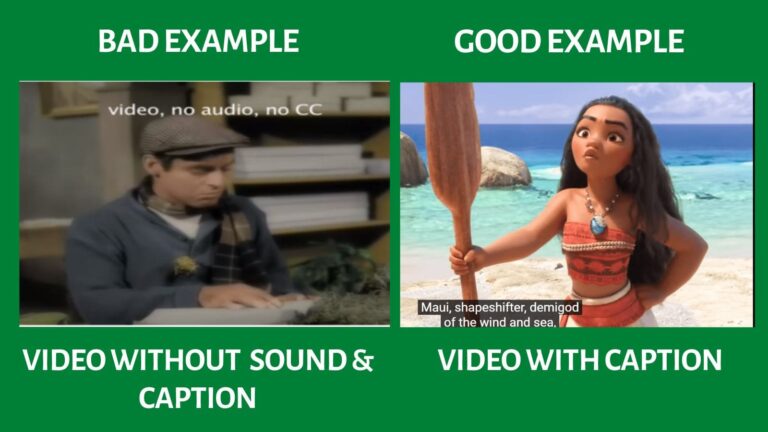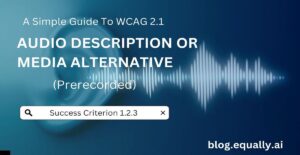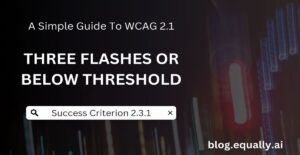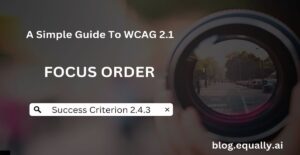WCAG Principle: Operable
Guideline 1.2: Time-based Media (Provide alternatives for time-based media).
Conformance Level: A (Minimal Requirement)
What is Success Criterion 1.2.2 Captions (Prerecorded)?
This success criterion requires captions for videos that include audio in the form of dialogue, voiceover, and other sound clues that together convey information.
Captions include not only dialogue, but also information such as speaker & non-speech information conveyed through sound, such as clapping and laughter from an audience.
How does it make your website accessible?
This success criterion requires captions for videos that include audio in the form of dialogue, voiceover, and other sound clues that together convey information.
Captions include not only dialogue, but also information such as speaker & non-speech information conveyed through sound, such as clapping and laughter from an audience.
Who benefits from proper captions
- People with hearing impairments (deaf or hard of hearing).
- People for whom English is a second language.
- People in noisy environments who cannot hear the sound from their devices.
Exceptions
You don’t need to provide captions if the video is itself an alternative for text.
How to Meet Success Criterion 1.2.2
Common mistakes with video captioning:
- The video does not have synchronized captions.
- The video has captions but they do not include all the spoken dialogue and important sound effects.
- The video has captions but they are not synchronized with the audio output.
How to fix mistakes:
- Add captions to all videos with sound.
- Caption all spoken word.
- Caption non-speech information (such as sound effects) as well.
- Establish the identity of both onscreen and offscreen speakers for clarity.
Helpful tips for developers:
- Embed all of the dialogue and important sounds as text in a fashion that causes the text not to be visible unless the user requests it.
- Provide your captions in verbatim. Keep editing to the barest minimum.
- Enable media synchronization in multimedia content that includes both audio and video.
- Use an accessible media player that can play the caption file in synchronization with the audio track.
- If possible provide captions in multiple languages as this helps users to choose the language they can follow.
- Automatically-generated captions often do not meet user needs or accessibility requirements, so don’t rely solely on them. Instead, hire the services of a manual caption provider.
How to test if you’ve met compliance:
- Watch the synchronized media with closed captioning turned off.
- Check that captions (of all dialogue and important sounds) are visible.
- Watch the synchronized media with closed captioning turned on.
- Check that captions (of all dialogue and important sounds) are visible.
Bad and Good Examples (Pictures and Developer Code)

BAd example of Code Snippet
<video controls poster="/images/sample.gif">
<source src="sample.mp4" type="video/mp4" />
<source src="sample.ogv" type="video/ogy" />
</video>good example of Code Snippet
<video controls poster="/images/sample.gif">
<source src="sample.mp4" type="video/mp4" />
<source src="sample.ogv" type="video/ogv" />
<track kind="captions" src=" sampleCaptions_en.vtt" srclang="en" />
<track kind="captions" src="sampleCaptions_es.vtt" srclang="es" />
<track kind="subtitles" src="sampleSubtitles_en.vtt" srclang="en" />
<track kind="subtitles" src="sampleSubtitles_es.vtt" srclang="es" />
</video>Frequently Asked Questions
What are captions?
Captions are a text version of speech that provides information to people who are deaf or hard-of-hearing, or people who process written content better than audio. Captions can either be ‘open’ or ‘closed’. Open captions are ‘burned’ into the video and are always visible on screen, while closed captions must be turned on by the viewer.
What are the characteristics of a good caption?
The characteristics of a good caption revolves around providing an exact and accurate description of the events in the audio. These include describing sound effects and identifying the speaker(s). As a general rule of thumb, a good caption must be clear, readable, error-free and easily accessible to anyone who needs it.
Are open captions accessible?
Open captions are not accessible to screen reader and other assistive technology users. This is because open captions are “burned” into the video and not provided as separate text a screen reader can read aloud. However, both open captions and closed captions have their pros and cons. Ultimately, it is up to you to decide the best captioning strategy for your video content.
How can I add captions to a video?
You can add captions to a video using several methods. Most people use captioning software programs and online services, while some prefer the do-it-yourself method. Find more information in this article on how to use Camtasia closed captions.
Does WCAG 2.1 require all videos on my website to have captions?
Absolutely! WCAG requires all videos to have captions on your website to have captions. Providing captions for both prerecorded and videos is one of the requirements to achieve WCAG 2.1 Level AA conformance.




